盐酸度洛西汀欧洲药典
盐酸度洛西汀FDA说明书(英文)
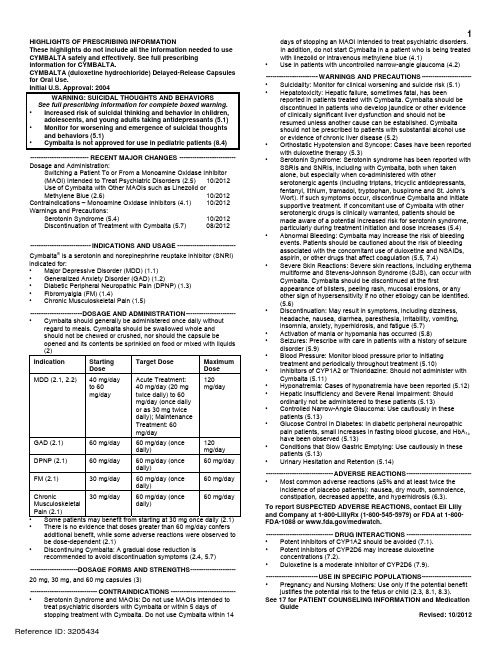
1HIGHLIGHTS OF PRESCRIBING INFORMATIONdays of stopping an MAOI intended to treat psychiatric disorders.These highlights do not include all the information needed to use In addition, do not start Cymbalta in a patient who is being treated CYMBALTA safely and effectively. See full prescribing with linezolid or intravenous methylene blue (4.1) information for CYMBALTA. •Use in patients with uncontrolled narrow-angle glaucoma (4.2)CYMBALTA (duloxetine hydrochloride) Delayed-Release Capsules for Oral Use.Initial U.S. Approval: 2004WARNING: SUICIDAL THOUGHTS AND BEHAVIORS See full prescribing information for complete boxed warning. • Increased risk of suicidal thinking and behavior in children,adolescents, and young adults taking antidepressants (5.1) • Monitor for worsening and emergence of suicidal thoughtsand behaviors (5.1) • Cymbalta is not approved for use in pediatric patients (8.4) ---------------------------RECENT MAJOR CHANGES --------------------------Dosage and Administration:Switching a Patient To or From a Monoamine Oxidase Inhibitor (MAOI) Intended to Treat Psychiatric Disorders (2.5) 10/2012 Use of Cymbalta with Other MAOIs such as Linezolid or Methylene Blue (2.6) 10/2012 Contraindications – Monoamine Oxidase Inhibitors (4.1) 10/2012 Warnings and Precautions: Serotonin Syndrome (5.4) 10/2012 Discontinuation of Treatment with Cymbalta (5.7) 08/2012 ----------------------------INDICATIONS AND USAGE ---------------------------Cymbalta ® is a serotonin and norepinephrine reuptake inhibitor (SNRI) indicated for: • Major Depressive Disorder (MDD) (1.1) • Generalized Anxiety Disorder (GAD) (1.2)• Diabetic Peripheral Neuropathic Pain (DPNP) (1.3)• Fibromyalgia (FM) (1.4)• Chronic Musculoskeletal Pain (1.5)------------------------DOSAGE AND ADMINISTRATION-----------------------• Cymbalta should generally be administered once daily withoutregard to meals. Cymbalta should be swallowed whole andshould not be chewed or crushed, nor should the capsule beopened and its contents be sprinkled on food or mixed with liquids (2) Indication Starting Dose Target DoseMaximumDose MDD (2.1, 2.2)40 mg/day to 60 mg/day Acute Treatment: 40 mg/day (20 mg twice daily) to 60 mg/day (once daily or as 30 mg twice daily); Maintenance Treatment: 60 mg/day 120 mg/day GAD (2.1) 60 mg/day 60 mg/day (once daily) 120mg/day DPNP (2.1) 60 mg/day 60 mg/day (once daily) 60 mg/day FM (2.1)30 mg/day 60 mg/day (once daily) 60 mg/day Chronic Musculoskeletal Pain (2.1)30 mg/day 60 mg/day (once daily) 60 mg/day • Some patients may benefit from starting at 30 mg once daily (2.1) • There is no evidence that doses greater than 60 mg/day confersadditional benefit, while some adverse reactions were observed to be dose-dependent (2.1) • D iscontinuing Cymbalta: A gradual dose reduction isrecommended to avoid discontinuation symptoms (2.4, 5.7) ----------------------DOSAGE FORMS AND STRENGTHS---------------------20 mg, 30 mg, and 60 mg capsules (3)-------------------------------CONTRAINDICATIONS ------------------------------• Serotonin Syndrome and MAOIs: Do not use MAOIs intended totreat psychiatric disorders with Cymbalta or within 5 days ofstopping treatment with Cymbalta. Do not use Cymbalta within 14------------------------WARNINGS AND PRECAUTIONS -----------------------• Suicidality: Monitor for clinical worsening and suicide risk (5.1) • Hepatotoxicity: Hepatic failure, sometimes fatal, has been reported in patients treated with Cymbalta. Cymbalta should be discontinued in patients who develop jaundice or other evidence of clinically significant liver dysfunction and should not be resumed unless another cause can be established. Cymbalta should not be prescribed to patients with substantial alcohol use or evidence of chronic liver disease (5.2)• Orthostatic Hypotension and Syncope: Cases have been reportedwith duloxetine therapy (5.3)• Serotonin Syndrome: Serotonin syndrome has been reported withSSRIs and SNRIs, including with Cymbalta, both when taken alone, but especially when co-administered with other serotonergic agents (including triptans, tricyclic antidepressants, fentanyl, lithium, tramadol, tryptophan, buspirone and St. John’s Wort). If such symptoms occur, discontinue Cymbalta and initiate supportive treatment. If concomitant use of Cymbalta with other serotonergic drugs is clinically warranted, patients should be made aware of a potential increased risk for serotonin syndrome, particularly during treatment initiation and dose increases (5.4) • Abnormal Bleeding: Cymbalta may increase the risk of bleedingevents. Patients should be cautioned about the risk of bleeding associated with the concomitant use of duloxetine and NSAIDs, aspirin, or other drugs that affect coagulation (5.5, 7.4)• Severe Skin Reactions: Severe skin reactions, including erythemamultiforme and Stevens-Johnson Syndrome (SJS), can occur with Cymbalta. Cymbalta should be discontinued at the firstappearance of blisters, peeling rash, mucosal erosions, or any other sign of hypersensitivity if no other etiology can be identified. (5.6)• Discontinuation: May result in symptoms, including dizziness,headache, nausea, diarrhea, paresthesia, irritability, vomiting, insomnia, anxiety, hyperhidrosis, and fatigue (5.7) • Activation of mania or hypomania has occurred (5.8)• Seizures: Prescribe with care in patients with a history of seizuredisorder (5.9)• Blood Pressure: Monitor blood pressure prior to initiatingtreatment and periodically throughout treatment (5.10)• Inhibitors of CYP1A2 or Thioridazine: Should not administer withCymbalta (5.11)• Hyponatremia: Cases of hyponatremia have been reported (5.12) • Hepatic Insufficiency and Severe Renal Impairment: Should ordinarily not be administered to these patients (5.13)• Controlled Narrow-Angle Glaucoma: Use cautiously in thesepatients (5.13)• Glucose Control in Diabetes: In diabetic peripheral neuropathicpain patients, small increases in fasting blood glucose, and HbA 1c have been observed (5.13)• Conditions that Slow Gastric Emptying: Use cautiously in these patients (5.13)• Urinary Hesitation and Retention (5.14)-------------------------------ADVERSE REACTIONS------------------------------• Most common adverse reactions (≥5% and at least twice theincidence of placebo patients): nausea, dry mouth, somnolence, constipation, decreased appetite, and hyperhidrosis (6.3). To report SUSPECTED ADVERSE REACTIONS, contact Eli Lilly and Company at 1-800-LillyRx (1-800-545-5979) or FDA at 1-800-FDA-1088 or /medwatch.-------------------------------DRUG INTERACTIONS ------------------------------• Potent inhibitors of CYP1A2 should be avoided (7.1). • Potent inhibitors of CYP2D6 may increase duloxetineconcentrations (7.2).• Duloxetine is a moderate inhibitor of CYP2D6 (7.9). ------------------------USE IN SPECIFIC POPULATIONS-----------------------• Pregnancy and Nursing Mothers: Use only if the potential benefitjustifies the potential risk to the fetus or child (2.3, 8.1, 8.3).See 17 for PATIENT COUNSELING INFORMATION and MedicationGuide Revised: 10/20122FULL PRESCRIBING INFORMATION: CONTENTS*WARNING: SUICIDAL THOUGHTS AND BEHAVIORS1 INDICATIONSANDUSAGE1.1 Major Depressive Disorder1.2 Generalized Anxiety Disorder1.3 Diabetic Peripheral Neuropathic Pain1.4 F ibromyalgia1.5 Chronic Musculoskeletal Pain2 DOSAGEANDADMINISTRATION2.1 I nitialTreatment2.2 M aintenance/Continuation/ExtendedTreatment2.3 Dosing in Special Populations2.4 D iscontinuingCymbalta2.5 Switching a Patient To or From a Monoamine OxidaseInhibitor (MAOI) Intended to Treat Psychiatric Disorders2.6 Use of Cymbalta with Other MAOIs such as Linezolid orMethylene Blue3 DOSAGE FORMS AND STRENGTHS4 CONTRAINDICATIONS4.1 Monoamine Oxidase Inhibitors (MAOIs)4.2 U ncontrolledNarrow-AngleGlaucoma5 WARNINGSANDPRECAUTIONS5.1 Suicidal Thoughts and Behaviors in Adolescents andYoung Adults5.2 H epatotoxicity5.3 Orthostatic Hypotension and Syncope5.4 S erotoninSyndrome5.5 A bnormalBleeding5.6 Severe Skin Reactions5.7 Discontinuation of Treatment with Cymbalta5.8 Activation of Mania/Hypomania5.9 S eizures5.10 Effect on Blood Pressure5.11 Clinically Important Drug Interactions5.12 H yponatremia5.13 Use in Patients with Concomitant Illness5.14 Urinary Hesitation and Retention5.15 L aboratoryTests6 ADVERSEREACTIONS6.1 Clinical Trial Data Sources6.2 Adverse Reactions Reported as Reasons forDiscontinuation of Treatment in Placebo-Controlled Trials6.3 Most Common Adverse Reactions6.4 Adverse Reactions Occurring at an Incidence of 5% orMore Among Duloxetine-Treated Patients in Placebo-Controlled Trials6.5 Adverse Reactions Occurring at an Incidence of 2% orMore Among Duloxetine-Treated Patients in Placebo-Controlled Trials6.6 Effects on Male and Female Sexual Function6.7 Vital Sign Changes6.8 W eightChanges6.9 L aboratoryChanges6.10 E lectrocardiogramChanges6.11 Other Adverse Reactions Observed During thePremarketing and Postmarketing Clinical Trial Evaluationof Duloxetine6.12 Postmarketing Spontaneous Reports7 DRUGINTERACTIONS7.1 Inhibitors of CYP1A27.2 Inhibitors of CYP2D67.3 Dual Inhibition of CYP1A2 and CYP2D67.4 Drugs that Interfere with Hemostasis (e.g., NSAIDs,Aspirin, and Warfarin)7.5 L orazepam7.6 T emazepam7.7 Drugs that Affect Gastric Acidity7.8 Drugs Metabolized by CYP1A27.9 Drugs Metabolized by CYP2D67.10 Drugs Metabolized by CYP2C97.11 Drugs Metabolized by CYP3A7.12 Drugs Metabolized by CYP2C197.13 Monoamine Oxidase Inhibitors (MAOIs)7.14 S erotonergicDrugs7.15 A lcohol7.16 C NSDrugs7.17 Drugs Highly Bound to Plasma Protein8 USE IN SPECIFIC POPULATIONS8.1 P regnancy8.2 Labor and Delivery8.3 N ursingMothers8.4 P ediatricUse8.5 G eriatricUse8.6 G ender8.7 S mokingStatus8.8 R ace8.9 H epaticInsufficiency8.10 Severe Renal Impairment9 DRUGABUSEANDDEPENDENCE9.2 A buse9.3 D ependence10 OVERDOSAGE10.1 Signs and Symptoms10.2 M anagementofOverdose11 DESCRIPTION12 CLINICAL PHARMACOLOGY12.1 Mechanism of Action12.2 P harmacodynamics12.3 P harmacokinetics13 NONCLINICAL TOXICOLOGY13.1 Carcinogenesis, Mutagenesis, Impairment of Fertility14 CLINICAL STUDIES14.1 Major Depressive Disorder14.2 Generalized Anxiety Disorder14.3 Diabetic Peripheral Neuropathic Pain14.4 F ibromyalgia14.5 Chronic Musculoskeletal Pain16 HOW SUPPLIED/STORAGE AND HANDLING16.1 H owSupplied16.2 S torage17 PATIENT COUNSELING INFORMATION17.1 Information on Medication Guide17.2 Suicidal Thoughts and Behaviors17.3 M edicationAdministration17.4 Continuing the Therapy Prescribed17.5 H epatotoxicity17.6 A lcohol17.7 Orthostatic Hypotension and Syncope17.8 S erotoninSyndrome17.9 A bnormalBleeding17.10 Severe Skin Reaction17.11 Discontinuation of Treatment17.12 Activation of Mania or Hypomania17.13 Seizures17.14 Effects on Blood Pressure17.15 Concomitant Medications17.16 Hyponatremia17.17 Concomitant Illnesses17.18 Urinary Hesitancy and Retention17.19 Pregnancy and Breast Feeding17.20 Interference with Psychomotor Performance* Sections or subsections omitted from the full prescribing information are not listed.FULL PRESCRIBING INFORMATIONWARNING: SUICIDAL THOUGHTS AND BEHAVIORSAntidepressants increased the risk of suicidal thoughts and behavior in children, adolescents, and young adults in short-term studies. These studies did not show an increase in the risk of suicidal thoughts and behavior with antidepressant use in patients over age 24; there was a reduction in risk with antidepressant use in patients aged 65 and older [see Warnings and Precautions (5.1)].In patients of all ages who are started on antidepressant therapy, monitor closely for worsening, and for emergence of suicidal thoughts and behaviors. Advise families and caregivers of the need for close observation and communication with the prescriber [see Warnings and Precautions (5.1)].Cymbalta is not approved for use in pediatric patients [see Use in Specific Populations (8.4)].USAGEAND1 INDICATIONS1.1 Major Depressive DisorderCymbalta is indicated for the treatment of major depressive disorder (MDD). The efficacy of Cymbalta was established in four short-term and one maintenance trial in adults [see Clinical Studies (14.1)].A major depressive episode (DSM-IV) implies a prominent and relatively persistent (nearly every day for at least 2 weeks) depressed or dysphoric mood that usually interferes with daily functioning, and includes at least 5 of the following 9 symptoms: depressed mood, loss of interest in usual activities, significant change in weight and/or appetite, insomnia or hypersomnia, psychomotor agitation or retardation, increased fatigue, feelings of guilt or worthlessness, slowed thinking or impaired concentration, or a suicide attempt or suicidal ideation.AnxietyDisorder1.2 GeneralizedCymbalta is indicated for the treatment of generalized anxiety disorder (GAD). The efficacy of Cymbalta was established in three short-term trials and one maintenance trial in adults [see Clinical Studies (14.2)].Generalized anxiety disorder is defined by the DSM-IV as excessive anxiety and worry, present more days than not, for at least 6 months. The excessive anxiety and worry must be difficult to control and must cause significant distress or impairment in normal functioning. It must be associated with at least 3 of the following 6 symptoms: restlessness or feeling keyed up or on edge, being easily fatigued, difficulty concentrating or mind going blank, irritability, muscle tension, and/or sleep disturbance.1.3 Diabetic Peripheral Neuropathic PainCymbalta is indicated for the management of neuropathic pain (DPNP) associated with diabetic peripheral neuropathy [see Clinical Studies (14.3)].1.4 FibromyalgiaCymbalta is indicated for the management of fibromyalgia (FM) [see Clinical Studies (14.4)].PainMusculoskeletal1.5 ChronicCymbalta is indicated for the management of chronic musculoskeletal pain. This has been established in studies in patients with chronic low back pain (CLBP) and chronic pain due to osteoarthritis [see Clinical Studies (14.5)].2 DOSAGE AND ADMINISTRATIONCymbalta should be swallowed whole and should not be chewed or crushed, nor should the capsule be opened and its contents sprinkled on food or mixed with liquids. All of these might affect the enteric coating. Cymbalta can be given without regard to meals.Treatment2.1 InitialMajor Depressive Disorder — Cymbalta should be administered at a total dose of 40 mg/day (given as 20 mg twice daily) to 60 mg/day (given either once daily or as 30 mg twice daily). For some patients, it may be desirable to start at 30 mg once daily for 1 week, to allow patients to adjust to the medication before increasing to 60 mg once daily. While a 120 mg/day dose was shown to be effective, there is no evidence that doses greater than 60 mg/day confer any additional benefits. The safety of doses above 120 mg/day has not been adequately evaluated [see Clinical Studies (14.1)].Generalized Anxiety Disorder — For most patients, the recommended starting dose for Cymbalta is 60 mg administered once daily. For some patients, it may be desirable to start at 30 mg once daily for 1 week, to allow patients to adjust to the medication before increasing to 60 mg once daily. While a 120 mg once daily dose was shown to be effective, there is no evidence that doses greater than 60 mg/day confer additional benefit. Nevertheless, if a decision is made to increase the dose beyond 60 mg once daily, dose increases should be in increments of 30 mg once daily. The safety of doses above 120 mg once daily has not been adequately evaluated [see Clinical Studies (14.2)].Diabetic Peripheral Neuropathic Pain — The recommended dose for Cymbalta is 60 mg administered once daily. There is no evidence that doses higher than 60 mg confer additional significant benefit and the higher dose is clearly less well tolerated [see Clinical Studies (14.3)]. For patients for whom tolerability is a concern, a lower starting dose may be considered.Since diabetes is frequently complicated by renal disease, a lower starting dose and gradual increase in dose should be considered for patients with renal impairment [see Dosage and Administration (2.3), Use in Specific Populations (8.10), and Clinical Pharmacology (12.3)].Fibromyalgia — The recommended dose for Cymbalta is 60 mg administered once daily. Treatment should begin at 30 mg once daily for 1 week, to allow patients to adjust to the medication before increasing to 60 mg once daily. Some patients may respond to the starting dose. There is no evidence that doses greater than 60 mg/day confer additional benefit, even in patients who do not respond to a 60 mg dose, and higher doses are associated with a higher rate of adverse reactions [see Clinical Studies (14.4)].Chronic Musculoskeletal Pain — The recommended dose for Cymbalta is 60 mg once daily. Dosing may be started at 30 mg for one week, to allow patients to adjust to the medication before increasing to 60 mg once daily. There is no evidence that higher doses confer additional benefit, even in patients who do not respond to a 60 mg dose, and higher doses are associated with a higher rate of adverse reactions [see Clinical Studies (14.5)].Treatment2.2 M aintenance/Continuation/ExtendedMajor Depressive Disorder — It is generally agreed that acute episodes of major depression require several months or longer of sustained pharmacologic therapy. Maintenance of efficacy in MDD was demonstrated with Cymbalta as monotherapy. Cymbalta should be administered at a total dose of 60 mg once daily. Patients should be periodically reassessed to determine the need for maintenance treatment and the appropriate dose for such treatment [see Clinical Studies (14.1)].Generalized Anxiety Disorder — It is generally agreed that episodes of generalized anxiety disorder require several months or longer of sustained pharmacological therapy. Maintenance of efficacy in GAD was demonstrated with Cymbalta as monotherapy. Cymbalta should be administered in a dose range of 60-120 mg once daily. Patients should be periodically reassessed to determine the continued need for maintenance treatment and the appropriate dose for such treatment [see Clinical Studies (14.2)].Diabetic Peripheral Neuropathic Pain — As the progression of diabetic peripheral neuropathy is highly variable and management of pain is empirical, the effectiveness of Cymbalta must be assessed individually. Efficacy beyond 12 weeks has not been systematically studied in placebo-controlled trials.Fibromyalgia — Fibromyalgia is recognized as a chronic condition. The efficacy of Cymbalta in the management of fibromyalgia has been demonstrated in placebo-controlled studies up to 3 months. The efficacy of Cymbalta was not demonstrated in longer studies; however, continued treatment should be based on individual patient response.Chronic Musculoskeletal Pain — The efficacy of Cymbalta has not been established in placebo-controlled studies beyond 13 weeks.2.3 Dosing in Special PopulationsHepatic Insufficiency — It is recommended that Cymbalta should ordinarily not be administered to patients with any hepatic insufficiency [see Warnings and Precautions (5.13) and Use in Specific Populations (8.9)].Severe Renal Impairment — Cymbalta is not recommended for patients with end-stage renal disease or severe renal impairment (estimated creatinine clearance <30 mL/min) [see Warnings and Precautions (5.13) and Use in Specific Populations (8.10)].Elderly Patients — No dose adjustment is recommended for elderly patients on the basis of age. As with any drug, caution should be exercised in treating the elderly. When individualizing the dosage in elderly patients, extra care should be taken when increasing the dose [see Use in Specific Populations (8.5)].Pregnant Women — There are no adequate and well-controlled studies in pregnant women; therefore, Cymbalta should be used during pregnancy only if the potential benefit justifies the potential risk to the fetus [see Use in Specific Populations (8.1)].Lilly maintains a pregnancy registry to monitor the pregnancy outcomes of women exposed to Cymbalta while pregnant. Healthcare providers are encouraged to register any patient who is exposed to Cymbalta during pregnancy by calling the Cymbalta Pregnancy Registry at 1-866-814-6975 or by visiting Nursing Mothers — Because the safety of duloxetine in infants is not known, nursing while on Cymbalta is not recommended [see Use in Specific Populations (8.3)].2.4 D iscontinuingCymbaltaSymptoms associated with discontinuation of Cymbalta and other SSRIs and SNRIs have been reported. A gradual reduction in the dose rather than abrupt cessation is recommended whenever possible [see Warnings and Precautions (5.7)].2.5 Switching a Patient To or From a Monoamine Oxidase Inhibitor (MAOI) Intended to Treat PsychiatricDisordersAt least 14 days should elapse between discontinuation of an MAOI intended to treat psychiatric disorders and initiation of therapy with Cymbalta. Conversely, at least 5 days should be allowed after stopping Cymbalta before starting an MAOI intended to treat psychiatric disorders [see Contraindications (4.1)].2.6 Use of Cymbalta with Other MAOIs such as Linezolid or Methylene BlueDo not start Cymbalta in a patient who is being treated with linezolid or intravenous methylene blue because there is an increased risk of serotonin syndrome. In a patient who requires more urgent treatment of a psychiatric condition, other interventions, including hospitalization, should be considered [see Contraindications (4.1)].In some cases, a patient already receiving Cymbalta therapy may require urgent treatment with linezolid or intravenous methylene blue. If acceptable alternatives to linezolid or intravenous methylene blue treatment are not available and the potential benefits of linezolid or intravenous methylene blue treatment are judged to outweigh the risks of serotonin syndrome in a particular patient, Cymbalta should be stopped promptly, and linezolid or intravenous methylene blue can be administered. The patient should be monitored for symptoms of serotonin syndrome for 5 days or until 24 hours after the last dose of linezolid or intravenous methylene blue, whichever comes first. Therapy with Cymbalta may be resumed 24 hours after the last dose of linezolid or intravenous methylene blue [see Warnings and Precautions (5.4)].The risk of administering methylene blue by non-intravenous routes (such as oral tablets or by local injection) or in intravenous doses much lower than 1 mg/kg with Cymbalta is unclear. The clinician should, nevertheless, be aware of the possibility of emergent symptoms of serotonin syndrome with such use [see Warnings and Precautions (5.4)].3 DOSAGE FORMS AND STRENGTHSCymbalta is available as delayed release capsules:20 mg opaque green capsules imprinted with “Lilly 3235 20mg”30 mg opaque white and blue capsules imprinted with “Lilly 3240 30mg”60 mg opaque green and blue capsules imprinted with “Lilly 3237 60mg”60 mg opaque green and blue capsules imprinted with “Lilly 3270 60mg”4 CONTRAINDICATIONS4.1 Monoamine Oxidase Inhibitors (MAOIs)The use of MAOIs intended to treat psychiatric disorders with Cymbalta or within 5 days of stopping treatment with Cymbalta is contraindicated because of an increased risk of serotonin syndrome. The use of Cymbalta within 14 days of stopping an MAOI intended to treat psychiatric disorders is also contraindicated [see Dosage and Administration (2.5) and Warnings and Precautions (5.4)].Starting Cymbalta in a patient who is being treated with MAOIs such as linezolid or intravenous methylene blue is also contraindicated because of an increased risk of serotonin syndrome [see Dosage and Administration (2.6) and Warnings and Precautions (5.4)].4.2 Uncontrolled Narrow-Angle GlaucomaIn clinical trials, Cymbalta use was associated with an increased risk of mydriasis; therefore, its use should be avoided in patients with uncontrolled narrow-angle glaucoma [see Warnings and Precautions (5.13)].PRECAUTIONS5 WARNINGSAND5.1 Suicidal Thoughts and Behaviors in Adolescents and Young AdultsPatients with major depressive disorder (MDD), both adult and pediatric, may experience worsening of their depression and/or the emergence of suicidal ideation and behavior (suicidality) or unusual changes in behavior, whether or not they are taking antidepressant medications, and this risk may persist until significant remission occurs. Suicide is a known risk of depression and certain other psychiatric disorders, and these disorders themselves are the strongest predictors of suicide. There has been a long-standing concern, however, that antidepressants may have a role in inducing worsening of depression and the emergence of suicidality in certain patients during the early phases of treatment.Pooled analyses of short-term placebo-controlled trials of antidepressant drugs (SSRIs and others) showed that these drugs increase the risk of suicidal thinking and behavior (suicidality) in children, adolescents, and young adults (ages 18-24) with major depressive disorder (MDD) and other psychiatric disorders. Short-term studies did not show an increase in the risk of suicidality with antidepressants compared to placebo in adults beyond age 24; there was a reduction with antidepressants compared to placebo in adults aged 65 and older.The pooled analyses of placebo-controlled trials in children and adolescents with MDD, obsessive compulsive disorder (OCD), or other psychiatric disorders included a total of 24 short-term trials of 9 antidepressant drugs in over 4400 patients. The pooled analyses of placebo-controlled trials in adults with MDD or other psychiatric disorders included a total of 295 short-term trials (median duration of 2 months) of 11 antidepressant drugs in over 77,000 patients. There was considerable variation in risk of suicidality among drugs, but a tendency toward an increase in the younger patients for almost all drugs studied. There were differences in absolute risk of suicidality across the different indications, with the highest incidence in MDD. The risk of differences (drug vs placebo), however, were relatively stable within age strata and across indications. These risk differences (drug-placebo difference in the number of cases of suicidality per 1000 patients treated) are provided in Table 1.Table 1Age Range Drug-Placebo Difference in Number of Cases ofSuicidality per 1000 Patients TreatedIncreases Compared to Placebo<18 14 additional cases18-24 5 additional cases Decreases Compared to Placebo25-64 1 fewer case≥65 6 fewer casesNo suicides occurred in any of the pediatric trials. There were suicides in the adult trials, but the number was notsufficient to reach any conclusion about drug effect on suicide.It is unknown whether the suicidality risk extends to longer-term use, i.e., beyond several months. However, thereis substantial evidence from placebo-controlled maintenance trials in adults with depression that the use ofantidepressants can delay the recurrence of depression.All patients being treated with antidepressants for any indication should be monitored appropriately andobserved closely for clinical worsening, suicidality, and unusual changes in behavior, especially during the initialfew months of a course of drug therapy, or at times of dose changes, either increases or decreases.The following symptoms, anxiety, agitation, panic attacks, insomnia, irritability, hostility, aggressiveness,impulsivity, akathisia (psychomotor restlessness), hypomania, and mania, have been reported in adult and pediatricpatients being treated with antidepressants for major depressive disorder as well as for other indications, both psychiatricand nonpsychiatric. Although a causal link between the emergence of such symptoms and either the worsening ofdepression and/or the emergence of suicidal impulses has not been established, there is concern that such symptomsmay represent precursors to emerging suicidality.Consideration should be given to changing the therapeutic regimen, including possibly discontinuing themedication, in patients whose depression is persistently worse, or who are experiencing emergent suicidality or symptomsthat might be precursors to worsening depression or suicidality, especially if these symptoms are severe, abrupt in onset,or were not part of the patient’s presenting symptoms.If the decision has been made to discontinue treatment, medication should be tapered, as rapidly as is feasible,but with recognition that discontinuation can be associated with certain symptoms [see Dosage and Administration (2.4)and Warnings and Precautions (5.7) for descriptions of the risks of discontinuation of Cymbalta].Families and caregivers of patients being treated with antidepressants for major depressive disorder orother indications, both psychiatric and nonpsychiatric, should be alerted about the need to monitor patients for the emergence of agitation, irritability, unusual changes in behavior, and the other symptoms described above, as well as the emergence of suicidality, and to report such symptoms immediately to health care providers. Such monitoring should include daily observation by families and caregivers. Prescriptions for Cymbalta should bewritten for the smallest quantity of capsules consistent with good patient management, in order to reduce therisk of overdose.Screening Patients for Bipolar Disorder — A major depressive episode may be the initial presentation of bipolardisorder. It is generally believed (though not established in controlled trials) that treating such an episode with anantidepressant alone may increase the likelihood of precipitation of a mixed/manic episode in patients at risk for bipolardisorder. Whether any of the symptoms described above represent such a conversion is unknown. However, prior toinitiating treatment with an antidepressant, patients with depressive symptoms should be adequately screened todetermine if they are at risk for bipolar disorder; such screening should include a detailed psychiatric history, including afamily history of suicide, bipolar disorder, and depression. It should be noted that Cymbalta (duloxetine) is not approvedfor use in treating bipolar depression.5.2 HepatotoxicityThere have been reports of hepatic failure, sometimes fatal, in patients treated with Cymbalta. These cases havepresented as hepatitis with abdominal pain, hepatomegaly, and elevation of transaminase levels to more than twenty times the upper limit of normal with or without jaundice, reflecting a mixed or hepatocellular pattern of liver injury. Cymbalta should be discontinued in patients who develop jaundice or other evidence of clinically significant liver dysfunction and should not be resumed unless another cause can be established.Cases of cholestatic jaundice with minimal elevation of transaminase levels have also been reported. Otherpostmarketing reports indicate that elevated transaminases, bilirubin, and alkaline phosphatase have occurred in patientswith chronic liver disease or cirrhosis.Cymbalta increased the risk of elevation of serum transaminase levels in development program clinical trials. Livertransaminase elevations resulted in the discontinuation of 0.3% (89/29,435) of Cymbalta-treated patients. In mostpatients, the median time to detection of the transaminase elevation was about two months. In placebo-controlled trials in any indication, for patients with normal and abnormal baseline ALT values, elevation of ALT >3 times the upper limit of normal occurred in 1.37% (132/9611) of Cymbalta-treated patients compared to 0.49% (35/7182) of placebo-treated patients. In placebo-controlled studies using a fixed dose design, there was evidence of a dose response relationship for ALT and AST elevation of >3 times the upper limit of normal and >5 times the upper limit of normal, respectively.。
度洛西汀片
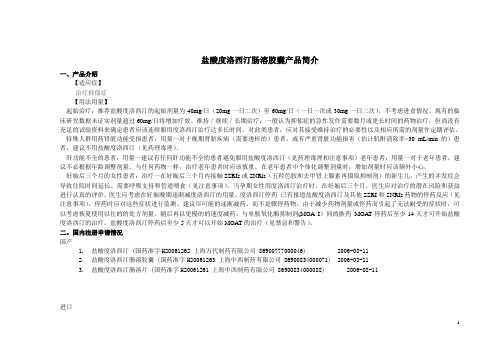
盐酸度洛西汀肠溶胶囊产品简介一、产品介绍【适应症】治疗抑郁症【用法用量】起始治疗:推荐盐酸度洛西汀的起始剂量为40mg/日(20mg一日二次)至60mg/日(一日一次或30mg一日二次),不考虑进食情况。
现有的临床研究数据未证实剂量超过60mg/日将增加疗效。
维持/继续/长期治疗:一般认为抑郁症的急性发作需要数月或更长时间的药物治疗,但尚没有充足的试验资料来确定患者应该连续服用度洛西汀治疗达多长时间。
对此类患者,应对其接受维持治疗的必要性以及相应所需的剂量作定期评估。
特殊人群用药肾脏功能受损患者:用量一对于晚期肾脏疾病(需要透析的)患者,或有严重肾脏功能损害(估计肌酐清除率<30 mL/min的)患者,建议不用盐酸度洛西汀(见药理毒理)。
肝功能不全的患者:用量一建议有任何肝功能不全的患者避免服用盐酸度洛西汀(见药理毒理和注意事项)老年患者:用量一对于老年患者,建议不必根据年龄调整剂量。
与任何药物一样,治疗老年患者时应该慎重。
在老年患者中个体化调整剂量时,增加剂量时应该额外小心。
妊娠后三个月的女性患者:治疗一在妊娠后三个月内接触SSRIs或SNRls(五羟色胺和去甲肾上腺素再摄取抑制剂)的新生儿,产生的并发症会导致住院时间延长、需要呼吸支持和管道喂食(见注意事项)。
当孕期女性用度洛西汀治疗时,在妊娠后三个月,医生应对治疗的潜在风险和获益进行认真的评价。
医生应考虑在妊娠晚期逐渐减度洛西汀的用量。
度洛西汀停药已有报道盐酸度洛西汀及其他SSRI和SNRIs药物的停药反应(见注意事项)。
停药时应对这些症状进行监测。
建议尽可能的逐渐减药,而不是骤停药物。
由于减少药物剂量或停药而引起了无法耐受的症状时,可以考虑恢夏使用以往的的处方剂量。
随后再以更慢的的速度减药。
与单胺氧化酶抑制剂(MOA I)间的换药MOAT停药后至少14天才可开始盐酸度洛西汀的治疗。
盐酸度洛西汀停药后至少5天才可以开始MOAT的治疗(见禁忌和警告)。
度洛西汀(奥思平)说明书

百济新特药房提供度洛西汀(奥思平)说明书,让您了解度洛西汀(奥思平)副作用、度洛西汀(奥思平)效果、不良反应等信息。
百济新特药房—全国连锁专科药房,医保定点药房,消费者信得过商店,专家指导用药,度洛西汀(奥思平)说明书如下:【奥思平药品名称】商品名:奥思平通用名名:盐酸度洛西汀肠溶片英文名称:Duloxetine Hydrochloride EntericTablets【奥思平成份】奥思平主要成分为盐酸度洛西汀。
【奥思平适应症】用于治疗抑郁症。
【奥思平用法用量】吞服,不要咀嚼和压碎。
推荐起始剂量为40mg/日(40mg,一日一次或20mg,一日二次)至60mg/日(一日一次),不考虑进食影响。
【奥思平禁忌】1、禁用于已知对度洛西汀或产品中任何非活性成分过敏的患者。
2、禁止与单胺氧化酶抑制剂联用,也不可以在单胺氧化酶抑制剂停药14天内使用奥思平;根据度洛西汀的半衰期,停用度洛西汀后至少5天,才能开始使用MAOIs。
3、临床显示度洛西汀有增加瞳孔散大的风险,因此未经控制的闭角型青光眼患者应避免使用度洛西汀。
【奥思平药物相互作用】度洛西汀通过两种CYP2D6和CYP1A2代谢,中度抑制CYP2D6,但不抑制也不诱导CYP1A2和CYP3A4。
与其他主要通过CYP2D6代谢,且治疗窗狭窄的药物(如:TCAs、Ic类抗心律失常药物、吩噻嗪)时,应谨慎。
【奥思平规格】20mg(以度洛西汀计)【奥思平贮藏】密封,置阴凉干燥处。
【奥思平有效期】24个月【奥思平批准文号】国药准字H20061261【奥思平生产企业】上海中西制药有限公司。
盐酸度洛西汀
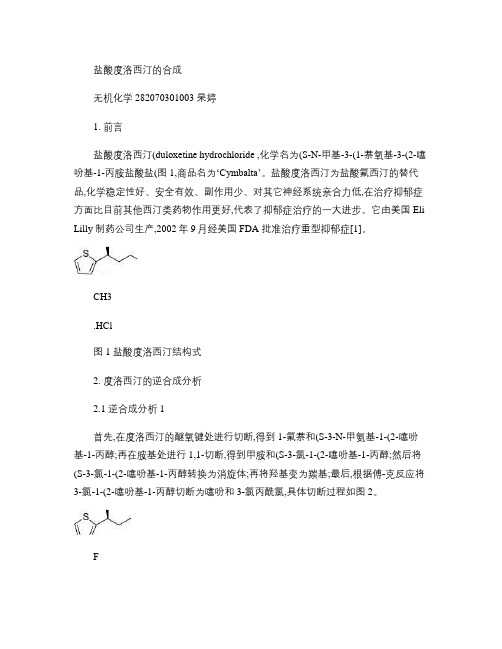
盐酸度洛西汀的合成无机化学282070301003 杲婷1. 前言盐酸度洛西汀(duloxetine hydrochloride ,化学名为(S-N-甲基-3-(1-萘氧基-3-(2-噻吩基-1-丙胺盐酸盐(图1,商品名为‘Cymbalta’。
盐酸度洛西汀为盐酸氟西汀的替代品,化学稳定性好、安全有效、副作用少、对其它神经系统亲合力低,在治疗抑郁症方面比目前其他西汀类药物作用更好,代表了抑郁症治疗的一大进步。
它由美国Eli Lilly 制药公司生产,2002年9月经美国FDA 批准治疗重型抑郁症[1]。
CH3.HCl图1 盐酸度洛西汀结构式2. 度洛西汀的逆合成分析2.1 逆合成分析1首先,在度洛西汀的醚氧键处进行切断,得到1-氟萘和(S-3-N-甲氨基-1-(2-噻吩基-1-丙醇;再在胺基处进行1,1-切断,得到甲胺和(S-3-氯-1-(2-噻吩基-1-丙醇;然后将(S-3-氯-1-(2-噻吩基-1-丙醇转换为消旋体;再将羟基变为羰基;最后,根据傅-克反应将3-氯-1-(2-噻吩基-1-丙醇切断为噻吩和3-氯丙酰氯,具体切断过程如图2。
F+CH3NH2+SClOHFGI SClOS+ClO图2 逆合成分析12.2逆合成分析2由于(S-3-N-甲氨基-1-(2-噻吩基-1-丙醇是合成度洛西汀的重要中间体,所以对其进行切断。
首先将甲氨基中的甲基转化为酯基;然后在酰胺处切断得到氯甲酸乙酯和(S-3-氨基-1-(2-噻吩基-1-丙醇;再将氨基转化为氰基,氰基转化为卤原子,羟基转化为羰基;最后同样根据傅-克反应得到原料噻吩和3-氯乙酰氯。
NFGINHCO2Et2+ClCO2EtFGI SCNOHFGIS ClOHFGI S ClOS+Cl ClO图3 逆合成分析22.3 逆合成分析3首先,在度洛西汀的醚氧键处进行切断,得到1-氟萘和(S-3-N-甲氨基-1-(2-噻吩基-1-丙醇;再将(S-3-N-甲氨基-1-(2-噻吩基-1-丙醇转化为消旋体3-N-甲氨基-1-(2-噻吩基-1-丙醇;然后添加官能团酯基,羟基转化为羰基;最后根据Mannich 反应,将3-N-苄基甲氨基-1-(2-噻吩基-1-丙酮切断为2-乙酰噻吩、甲醛和N-甲基苄氨。
奥思平(盐酸度洛西汀肠溶片)药品说明书
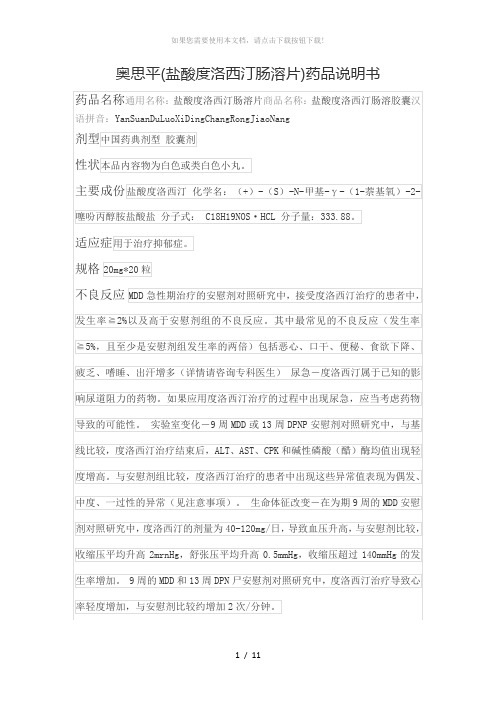
导致 0.4%(31/8454)度洛西汀治疗的患者中断治疗。这些患者出现 转氨酶升 高的时间中位数为 2 个月。在抑郁症患者中进行的对照试验中,09%(8/930)用 度洛西汀治 疗的患 者 ALT 升高超 过正 常上限 3 倍 以上 , 而 安慰剂组中为 0.3%(2/652)。所有安慰剂对照研究中,度洛西汀组中有 1%(39/3732)的患者 ALT 升高超过正常上限 3 倍以上,而安慰剂组中为 0.2%(6/2568)。固定剂量的 安慰剂对照研究中,有证据显示 ALT 升高超过正常上限 3 倍和 AST 升高超过正 常上限 5 倍,与药物剂量有量效关系。 度洛西汀通常不用于有习惯性饮酒和慢性肝病患者的治疗。 治疗开始前应测量血压,治疗后应定期测量。 在酒精使用患者或既往有肝病史的患者中,度洛西汀应慎用。 既往有癫痫发作史的患者慎用度洛西汀。 既往有躁狂史的患者慎用度洛西汀 停药-已对度洛西汀的停药症状做过系统研究。在抑郁症患者中进行的为期 9 周 的安慰剂对照试验中,骤停药物,观察到度洛西汀治疗的患者发生率 2%或明显 高于骤停安慰剂的症状包括:头晕,恶心,头痛,感
噻吩丙醇胺盐酸盐 分子式: C18H19NOS·HCL 分子量:333.88。
适应症用于治疗抑郁症。 规格 20mg*20 粒 不良反应 MDD 急性期治疗的安慰剂对照研究中,接受度洛西汀治疗的患者中,
发生率≧2%以及高于安慰剂组的不良反应。其中最常见的不良反应(发生率 ≧5%,且至少是安慰剂组发生率的两倍)包括恶心、口干、便秘、食欲下降、 疲乏、嗜睡、出汗增多(详情请咨询专科医生) 尿急-度洛西汀属于已知的影 响尿道阻力的药物。如果应用度洛西汀治疗的过程中出现尿急,应当考虑药物 导致的可能性。 实验室变化-9 周 MDD 或 13 周 DPNP 安慰剂对照研究中,与基 线比较,度洛西汀治疗结束后,ALT、AST、CPK 和碱性磷酸(醋)酶均值出现轻 度增高。与安慰剂组比较,度洛西汀治疗的患者中出现这些异常值表现为偶发、 中度、一过性的异常(见注意事项)。 生命体征改变-在为期 9 周的 MDD 安慰 剂对照研究中,度洛西汀的剂量为 40-120mg/日,导致血压升高,与安慰剂比较, 收缩压平均升高 2mrnHg,舒张压平均升高 0.5mmHg,收缩压超过 140mmHg 的发 生率增加。 9 周的 MDD 和 13 周 DPN 尸安慰剂对照研究中,度洛西汀治疗导致心 率轻度增加,与安慰剂比较约增加 2 次/分钟。
盐酸度洛西汀肠溶胶囊20140728

盐酸度洛西汀肠溶胶囊项目立项论证意见稿1.简介盐酸度洛西汀(duloxetine hydrochloride/Cymbaha,以下简称为度洛西汀)是美国礼来Eli Lilly公司开发的一个5一羟色胺和去甲肾上腺素再摄取抑制剂。
5一羟色胺和去甲肾上腺素均属中枢神经递质,在调控情感和对疼痛的敏度方面起着重要作用。
度洛西汀能够抑制神经元对5一羟色胺和去甲肾上腺素的再摄取,由此提高这两种中枢神经递质在大脑和脊髓中的浓度,故可用于治疗某些心境疾病如抑郁症和焦虑症以及缓解中枢性疼痛如糖尿病外周神经病性疼痛和妇女纤维肌痛等。
度洛西汀也能作用于尿道中的5一羟色胺和去甲肾上腺素受体,从而增强尿道括约肌的神经性紧张程度和收缩能力,所以对妇女应激性尿失禁症治疗也有效。
度洛西汀为口服肠溶胶囊制剂,2004年8月首次在美国获得批准后,现已在70余个国家上市。
度洛西汀2006年的全球销售额即超过13亿美元,2007年和2008年的销售额又分别大幅增至2l亿和27亿美元,是近年世界范围内销售额增长最快的药物之一。
化学名称:盐酸度洛西汀;(S)-(+)-N-甲基-3-(1-萘氧基)-3-(2-噻吩)-丙胺盐酸盐Duloxetinehydrochloride;N-Methyl-gama-(1-naphthalenyloxy)-2-thiophenepropanamine分子式:C18H19NOS.HCl;C18H20ClNOS分子量:333.88结构式:CAS:136434-34-9【用途】对于抑郁症、糖尿病性周围神经病引起疼痛以及紧张性尿失禁有疗效。
2.原料药来源国家局已批2家企业生产,0家进口原料药。
如下:1.盐酸度洛西汀(国药准字H261262上海万代制药有限公司86977746)2.盐酸度洛西汀 (国药准字H20130055江苏恩华药业股份有限公司86901435000170)3.国内上市批准情况国内盐酸度洛西汀主要为肠溶片和肠溶胶囊。
盐酸度洛西汀欧洲药典
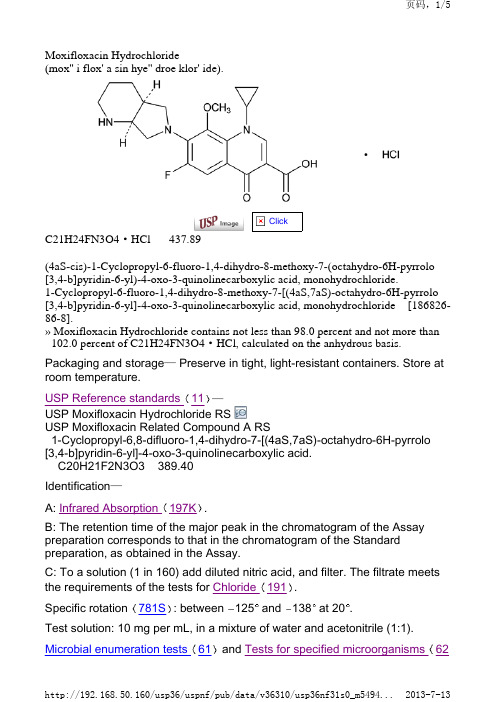
Moxifloxacin Hydrochloride(mox'' i flox' a sin hye'' droe klor' ide).C21H24FN3O4·HCl 437.89(4aS-cis)-1-Cyclopropyl-6-fluoro-1,4-dihydro-8-methoxy-7-(octahydro-6H-pyrrolo[3,4-b]pyridin-6-yl)-4-oxo-3-quinolinecarboxylic acid, monohydrochloride.1-Cyclopropyl-6-fluoro-1,4-dihydro-8-methoxy-7-[(4aS,7aS)-octahydro-6H-pyrrolo[3,4-b]pyridin-6-yl]-4-oxo-3-quinolinecarboxylic acid, monohydrochloride [186826-86-8].» Moxifloxacin Hydrochloride contains not less than 98.0 percent and not more than 102.0 percent of C21H24FN3O4·HCl, calculated on the anhydrous basis.Packaging and storage — Preserve in tight, light-resistant containers. Store at room temperature. USP Reference standards 11—USP Moxifloxacin Hydrochloride RSUSP Moxifloxacin Related Compound A RS1-Cyclopropyl-6,8-difluoro-1,4-dihydro-7-[(4aS,7aS)-octahydro-6H-pyrrolo[3,4-b]pyridin-6-yl]-4-oxo-3-quinolinecarboxylic acid.C20H21F2N3O3 389.40Identification —A: Infrared Absorption 197K .B: The retention time of the major peak in the chromatogram of the Assay preparation corresponds to that in the chromatogram of the Standard preparation, as obtained in the Assay.C: To a solution (1 in 160) add diluted nitric acid, and filter. The filtrate meets the requirements of the tests for Chloride 191.Specific rotation 781S : between 125 and 138 at 20.Test solution: 10 mg per mL, in a mixture of water and acetonitrile (1:1). Microbial enumeration tests 61 and Tests for specified microorganisms62Click— The total aerobic microbial count does not exceed 1000 cfu per g, and the total combined molds and yeasts count does not exceed 100 cfu per g.pH 791: between 3.9 and 4.6, in a solution (0.2 in 100).Water, Method Ia 921: not more than 4.5%.Residue on ignition 281: not more than 0.1%.Sulfate 221— A 0.6-g portion shows no more sulfate than corresponds to 0.25 mL of 0.020 N sulfuric acid (0.04%).Related compounds— [note—Protect solutions from light. ]Mobile phase and Diluent— Prepare as directed in the Assay.Blank solution— Use the Diluent.Resolution solution— Prepare as directed in the Assay.Sensitivity solution— Dilute an accurately measured volume of the Standard solution with Diluent to obtain a solution containing about 0.05 µg per mL. [note—Store the Sensitivity solution under refrigeration and protected from light. ] Standard solution— Dissolve an accurately weighed quantity of USP Moxifloxacin Hydrochloride RS in Diluent, and dilute quantitatively, and stepwise if necessary, with Diluent to obtain a solution having a known concentration of about 0.002 mg per mL.Test solution— Use the Assay preparation.Chromatographic system (see Chromatography 621)—Prepare the Chromatographic system as directed in the Assay. Chromatograph the Resolution solution, and record the peak responses as directed for Procedure: the resolution, R, between moxifloxacin and moxifloxacin related compound A is not less than 1.5. Chromatograph the Standard solution, and record the peak responses as directed for Procedure: the column efficiency using the moxifloxacin peak is not less than 4000 theoretical plates; the tailing factor is not more than 2.0; and the relative standard deviation for replicate injections is not more than 2.0%. In addition, chromatograph the Sensitivity solution, and record the peak response as directed for Procedure. Confirm that the signal-to-noise ratio of the moxifloxacin peak is not less than 10.Procedure— Separately inject equal volumes (about 25 µL) of the Blank solution, the Standard solution, and the Test solution into the chromatograph, record the chromatograms for at least 2 times the retention time of moxifloxacin, and measure the peak responses, disregarding any peaks corresponding to those obtained from the Blank solution. Calculate the percentage of each impurity in the portion of Moxifloxacin Hydrochloride taken by the formula:(CS / CU)(1/F)(100)(ri / rS)in which CS is the concentration, in mg per mL, of USP MoxifloxacinHydrochloride RS in the Standard solution; CU is the concentration, in mg per mL, of Moxifloxacin Hydrochloride in the Test solution; F is the relativeresponse factor for the individual related compound; ri is the peak response of each individual impurity; rS is the peak response of moxifloxacin in theStandard solution; and 100 is the conversion factor to percentage. The limits as shown in Table 1 are met. Table 1Assay —Buffer solution — Dissolve 0.5 g of tetrabutylammonium hydrogen sulfate and 1.0 g of monobasic potassium phosphate in water, add 2 mL of phosphoric acid, dilute with water to 1000 mL, mix, and pass through a 0.45-µm filter. Mobile phase — Prepare a degassed mixture of Buffer solution and methanol (18:7). Make adjustments if necessary (see System Suitability underChromatography 621).Diluent — Add 20 mg of anhydrous sodium sulfite to 1000 mL of BufferRelated Compound F RelativeRetentionTime vs.MoxifloxacinLimit (%)Moxifloxacin related compound A 11.0 1.150.16,8-Dimethoxy 20.71 1.320.18-Ethoxy 31.0 1.480.16-Methoxy-8-fluoro 41.0 1.710.18-Hydroxy 50.29 1.830.1Other individualimpurity1.0—0.1Total impurities ——0.51 1-Cyclopropyl-6,8-difluoro-7-[(4aS,7aS)-octahydro-6H-pyrrolo[3,4-b]pyridin-6-yl]-4-oxo-1,4-dihydroquinoline-3-carboxylic acid.2 1-Cyclopropyl-6,8-dimethoxy-7-[(4aS,7aS)-octahydro-6H-pyrrolo[3,4-b]pyridin-6-yl]-4-oxo-1,4-dihydroquinoline-3-carboxylic acid.3 1-Cyclopropyl-8-ethoxy-6-fluoro-7-[(4aS,7aS)-octahydro-6H-pyrrolo[3,4-b]pyridin-6-yl]-4-oxo-1,4-dihydroquinoline-3-carboxylic acid.4 1-Cyclopropyl-8-fluoro-6-methoxy-7-[(4aS,7aS)-octahydro-6H-pyrrolo[3,4-b]pyridin-6-yl]-4-oxo-1,4-dihydroquinoline-3-carboxylic acid.5 1-Cyclopropyl-6-fluoro-8-hydroxy-7-[(4aS,7aS)-octahydro-6H-pyrrolo[3,4-b]pyridin-6-yl]-4-oxo-1,4-dihydroquinoline-3-carboxylic acid.solution, mix gently, and pass through a 0.45-µm filter.Resolution solution— Dissolve suitable quantities of USP Moxifloxacin Hydrochloride RS and USP Moxifloxacin Related Compound A RS in Diluent to obtain a solution containing about 0.1 mg per mL and 0.001 mg per mL, respectively.Standard preparation— Dissolve an accurately weighed quantity of USP Moxifloxacin Hydrochloride RS in Diluent, and dilute quantitatively, and stepwise if necessary, with Diluent to obtain a solution having a known concentration of about 0.1 mg per mL.Assay preparation— Transfer about 50 mg of Moxifloxacin Hydrochloride, accurately weighed, to a 10-mL volumetric flask, dissolve in and dilute with Diluent to volume, and mix. Transfer 1.0 mL of this solution to a 50-mL volumetric flask, dilute with Diluent to volume, and mix.Chromatographic system (see Chromatography 621)— The liquid chromatograph is equipped with a 293-nm detector and 4.0-mm × 25-cm column that contains 5-µm packing L11. The flow rate is about 0.9 mL per minute. The column temperature is maintained at 45. Chromatograph the Resolution solution as directed for Procedure, and identify the components based on their relative retention times (about 1.0 for moxifloxacin and 1.2 for moxifloxacin related compound A). The resolution, R, between moxifloxacin and moxifloxacin related compound A is not less than 1.5. Chromatograph the Standard preparation, and record the peak responses as directed for Procedure: the column efficiency using the moxifloxacin peak is not less than 4000 theoretical plates; the tailing factor is not more than 2.0; and the relative standard deviation for replicate injections is not more than 2.0%. Procedure— Separately inject equal volumes (about 25 µL) of the Standard preparation and the Assay preparation into the chromatograph, record the chromatograms, and measure the responses for the major peaks. Calculate the percentage of C21H24FN3O4·HCl in the portion of Moxifloxacin Hydrochloride taken by the formula:100(CS / CU)(rU / rS)in which 100 is the conversion factor to percentage; CS is the concentration, in mg per mL, of USP Moxifloxacin Hydrochloride RS in the Standard preparation; CU is the concentration, in mg per mL, of Moxifloxacin Hydrochloride in the Assay preparation; and rU and rS are the peak responses obtained from the Assay preparation and the Standard preparation, respectively.Auxiliary Information— Please check for your question in the FAQs before contacting USP.Topic/Question Contact Expert CommitteeMonograph Leonel M. Santos, Ph.D.(SM12010) Monographs - SmallUSP36–NF31 Page 4412 Pharmacopeial Forum: Volume No. 34(5) Page 1170Chromatographic Column —MOXIFLOXACIN HYDROCHLORIDEChromatographic columns text is not derived from, and not part of, USP 36 or NF 31.Senior Scientific Liaison 1-301-816-8168Molecules 1Reference Standards RS Technical Services1-301-816-8129rstech@61Radhakrishna S Tirumalai, Ph.D. Principal Scientific Liaison1-301-816-8339(GCM2010) General Chapters - Microbiology62Radhakrishna S Tirumalai, Ph.D. Principal Scientific Liaison1-301-816-8339(GCM2010) General Chapters - Microbiology。
盐酸度洛西汀质量标准
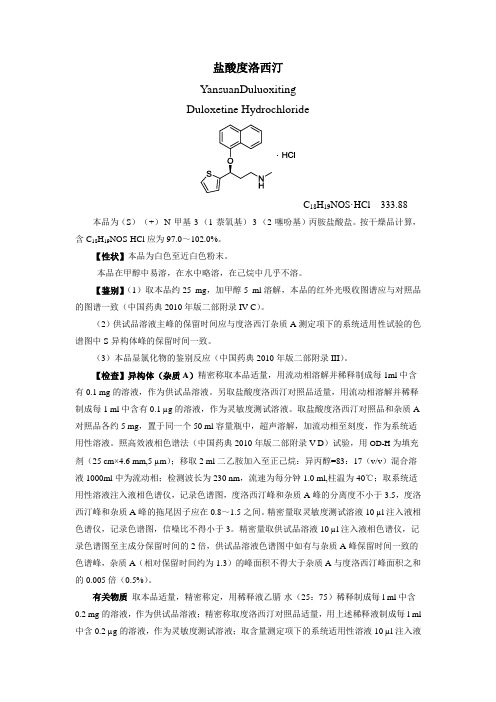
盐酸度洛西汀YansuanDuluoxitingDuloxetine HydrochlorideC18H19NOS·HCl 333.88 本品为(S)-(+)-N-甲基-3-(1-萘氧基)-3-(2-噻吩基)丙胺盐酸盐。
按干燥品计算,含C18H19NOS·HCl应为97.0~102.0%。
【性状】本品为白色至近白色粉末。
本品在甲醇中易溶,在水中略溶,在己烷中几乎不溶。
【鉴别】(1)取本品约25 mg,加甲醇5 ml溶解,本品的红外光吸收图谱应与对照品的图谱一致(中国药典2010年版二部附录IV C)。
(2)供试品溶液主峰的保留时间应与度洛西汀杂质A测定项下的系统适用性试验的色谱图中S-异构体峰的保留时间一致。
(3)本品显氯化物的鉴别反应(中国药典2010年版二部附录III)。
【检查】异构体(杂质A)精密称取本品适量,用流动相溶解并稀释制成每1ml中含有0.1 mg的溶液,作为供试品溶液。
另取盐酸度洛西汀对照品适量,用流动相溶解并稀释制成每1 ml中含有0.1 µg的溶液,作为灵敏度测试溶液。
取盐酸度洛西汀对照品和杂质A 对照品各约5 mg,置于同一个50 ml容量瓶中,超声溶解,加流动相至刻度,作为系统适用性溶液。
照高效液相色谱法(中国药典2010年版二部附录V D)试验,用OD-H为填充剂(25 cm×4.6 mm,5 µm);移取2 ml二乙胺加入至正己烷:异丙醇=83:17(v/v)混合溶液1000ml中为流动相;检测波长为230 nm,流速为每分钟1.0 ml,柱温为40℃;取系统适用性溶液注入液相色谱仪,记录色谱图,度洛西汀峰和杂质A峰的分离度不小于3.5,度洛西汀峰和杂质A峰的拖尾因子应在0.8~1.5之间。
精密量取灵敏度测试溶液10 µl注入液相色谱仪,记录色谱图,信噪比不得小于3。
精密量取供试品溶液10 µl注入液相色谱仪,记录色谱图至主成分保留时间的2倍,供试品溶液色谱图中如有与杂质A峰保留时间一致的色谱峰,杂质A(相对保留时间约为1.3)的峰面积不得大于杂质A与度洛西汀峰面积之和的0.005倍(0.5%)。
FDA批准度洛西汀治疗慢性肌肉骨骼疼痛
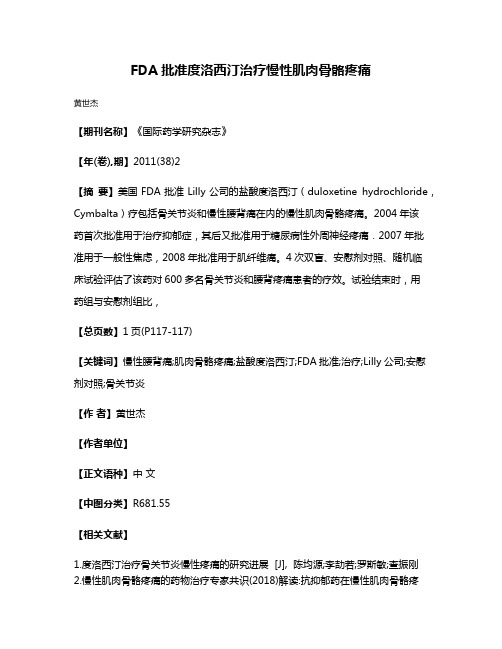
FDA批准度洛西汀治疗慢性肌肉骨骼疼痛
黄世杰
【期刊名称】《国际药学研究杂志》
【年(卷),期】2011(38)2
【摘要】美国FDA批准Lilly公司的盐酸度洛西汀(duloxetine hydrochloride,Cymbalta)疗包括骨关节炎和慢性腰背痛在内的慢性肌肉骨骼疼痛。
2004年该
药首次批准用于治疗抑郁症,其后又批准用于糖尿病性外周神经疼痛.2007年批准用于一般性焦虑,2008年批准用于肌纤维痛。
4次双盲、安慰剂对照、随机临
床试验评估了该药对600多名骨关节炎和腰背疼痛患者的疗效。
试验结束时,用
药组与安慰剂组比,
【总页数】1页(P117-117)
【关键词】慢性腰背痛;肌肉骨骼疼痛;盐酸度洛西汀;FDA批准;治疗;Lilly公司;安慰剂对照;骨关节炎
【作者】黄世杰
【作者单位】
【正文语种】中文
【中图分类】R681.55
【相关文献】
1.度洛西汀治疗骨关节炎慢性疼痛的研究进展 [J], 陈均源;李劼若;罗斯敏;查振刚
2.慢性肌肉骨骼疼痛的药物治疗专家共识(2018)解读:抗抑郁药在慢性肌肉骨骼疼
痛中的临床应用 [J], 聂中标; 饶跃峰; 陈建平; 冯智英; 樊碧发
3.口服度洛西汀联合局部内热针治疗慢性颈肩背部肌筋膜疼痛综合征的疗效 [J], 汤达承;李晓宏;黄翔;陈盼;邓翠芬
4.口服度洛西汀联合局部内热针治疗慢性颈肩背部肌筋膜疼痛综合征的疗效 [J], 汤达承;李晓宏;黄翔;陈盼;邓翠芬
5.美FDA批准盐酸度洛西汀治疗慢性肌骨骼疼痛 [J], 马培奇
因版权原因,仅展示原文概要,查看原文内容请购买。
度洛西汀

下列噻吩化合物经Marmieh反应,然后用Yarnaguchi-Masher-Pohland(YMP)复合试剂LiAl2H2在乙醚中,于 -78℃进行不对称还原,而后加入氢溴酸,使还原产物以氢溴酸盐形式得到。再和1-氟萘进行烷基化反应,最后 去甲基化,产物以草酸盐的形式得到。
相关药品说AOIs)均抑制5-HT代谢,两药合用易出现严重不良反应,如中枢神经毒性或5HT综合征(其临床表现为高血压、高热、肌阵挛、激惹及烦躁不安、反射亢进、出汗、寒战及震颤),甚至死亡。 禁止本药与MAOIs合用;停用MAOIs 14天后才能使用本药;停用本药5天后才能使用MAOIs。2.卷曲霉素、依诺沙 星、氟伏沙明及奎尼丁可抑制本药的代谢,增加本药血药浓度(或生物利用度)及毒性,两者合用须监测不良反应, 需要时减少本药剂量。3.本药与氟西汀、帕罗西汀合用,互相抑制代谢,两药的生物利用度、血药浓度均增加, 发生严重不良反应的危险性增加,合用时应调整两药剂量。4.本药可抑制三环类抗抑郁药(如阿米替林)的代谢, 两者合用,本药可增加后者的生物利用度、血药浓度及毒性。如必须合用,应密切监测三环类抗抑郁药的血药浓 度、中毒的症状及体征(抗胆碱能作用、过度镇静、意识混乱及心律失常)。5.本药可抑制吩噻嗪类药(奋乃静)的 代谢,增加后者的血药浓度及毒性(过度镇静、意识障碍、心律失常、直立性低血压、高热及锥体外系反应)。两 者合用应监测不良反应,必要时减少剂量。6.本药可抑制硫利达嗪的代谢,增加后者血药浓度及心脏毒性(QT间 期延长、尖端扭转性室性心动过速、心脏停搏),两者不应合用。7.本药可抑制Ic类抗心律失常药的代谢,增加 后者的血药浓度及心脏毒性。两者合用应密切监测Ic类抗心律失常药的血药浓度及心电图。8.本药与中枢神经系 统抑制药合用,可引起精神运动性障碍恶化,禁止两者合用。食物不影响本药的血药峰浓度,但可减慢吸收,并 降低吸收度10% 。
盐酸度洛西汀肠溶胶囊20140728

盐酸度洛西汀肠溶胶囊项目立项论证意见稿1.简介盐酸度洛西汀(duloxetine hydrochloride/Cymbaha,以下简称为度洛西汀)是美国礼来Eli Lilly公司开发的一个5一羟色胺和去甲肾上腺素再摄取抑制剂。
5一羟色胺和去甲肾上腺素均属中枢神经递质,在调控情感和对疼痛的敏度方面起着重要作用。
度洛西汀能够抑制神经元对5一羟色胺和去甲肾上腺素的再摄取,由此提高这两种中枢神经递质在大脑和脊髓中的浓度,故可用于治疗某些心境疾病如抑郁症和焦虑症以及缓解中枢性疼痛如糖尿病外周神经病性疼痛和妇女纤维肌痛等。
度洛西汀也能作用于尿道中的5一羟色胺和去甲肾上腺素受体,从而增强尿道括约肌的神经性紧张程度和收缩能力,所以对妇女应激性尿失禁症治疗也有效。
度洛西汀为口服肠溶胶囊制剂,2004年8月首次在美国获得批准后,现已在70余个国家上市。
度洛西汀2006年的全球销售额即超过13亿美元,2007年和2008年的销售额又分别大幅增至2l亿和27亿美元,是近年世界范围内销售额增长最快的药物之一。
化学名称:盐酸度洛西汀;(S)-(+)-N-甲基-3-(1-萘氧基)-3-(2-噻吩)-丙胺盐酸盐Duloxetinehydrochloride;N-Methyl-gama-(1-naphthalenyloxy)-2-thiophenepropanamine分子式:C18H19NOS.HCl;C18H20ClNOS分子量:333.88结构式:CAS:136434-34-9【用途】对于抑郁症、糖尿病性周围神经病引起疼痛以及紧张性尿失禁有疗效。
2.原料药来源国家局已批2家企业生产,0家进口原料药。
如下:1.盐酸度洛西汀(国药准字H261262上海万代制药有限公司86977746)2.盐酸度洛西汀 (国药准字H20130055江苏恩华药业股份有限公司86901435000170)3.国内上市批准情况国内盐酸度洛西汀主要为肠溶片和肠溶胶囊。
——————盐酸度洛西汀——————
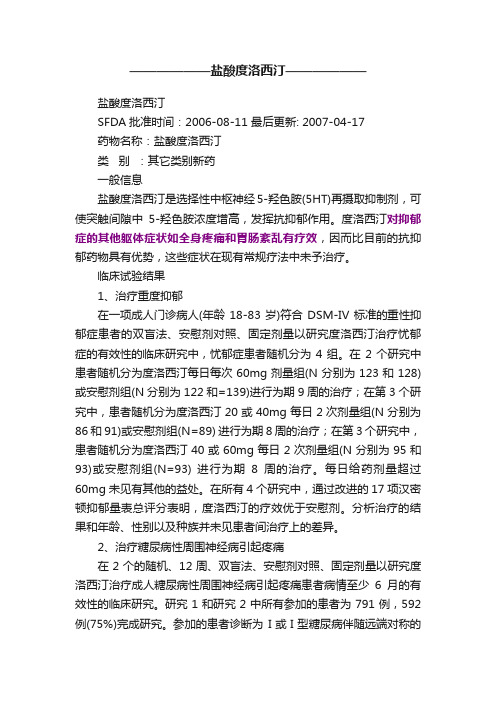
——————盐酸度洛西汀——————盐酸度洛西汀SFDA批准时间:2006-08-11 最后更新: 2007-04-17药物名称:盐酸度洛西汀类别:其它类别新药一般信息盐酸度洛西汀是选择性中枢神经5-羟色胺(5HT)再摄取抑制剂,可使突触间隙中5-羟色胺浓度增高,发挥抗抑郁作用。
度洛西汀对抑郁症的其他躯体症状如全身疼痛和胃肠紊乱有疗效,因而比目前的抗抑郁药物具有优势,这些症状在现有常规疗法中未予治疗。
临床试验结果1、治疗重度抑郁在一项成人门诊病人(年龄18-83岁)符合DSM-IV标准的重性抑郁症患者的双盲法、安慰剂对照、固定剂量以研究度洛西汀治疗忧郁症的有效性的临床研究中,忧郁症患者随机分为4组。
在2个研究中患者随机分为度洛西汀每日每次60mg剂量组(N分别为123和128)或安慰剂组(N分别为122和=139)进行为期9周的治疗;在第3个研究中,患者随机分为度洛西汀20或40mg每日2次剂量组(N分别为86和91)或安慰剂组(N=89) 进行为期8周的治疗;在第3个研究中,患者随机分为度洛西汀40或60mg每日2次剂量组(N分别为95和93)或安慰剂组(N=93) 进行为期8周的治疗。
每日给药剂量超过60mg未见有其他的益处。
在所有4个研究中,通过改进的17项汉密顿抑郁量表总评分表明,度洛西汀的疗效优于安慰剂。
分析治疗的结果和年龄、性别以及种族并未见患者间治疗上的差异。
2、治疗糖尿病性周围神经病引起疼痛在2个的随机、12周、双盲法、安慰剂对照、固定剂量以研究度洛西汀治疗成人糖尿病性周围神经病引起疼痛患者病情至少6月的有效性的临床研究。
研究1和研究2中所有参加的患者为791例,592 例(75%)完成研究。
参加的患者诊断为I或I型糖尿病伴随远端对称的感觉运动多发性神经病疼痛至少6月,患者基于11点的评分标准(0-10,0为没有疼痛,10为最严重的疼痛) 的基准的疼痛评分≥4。
患者必要时每日可服用4g的对乙酰氨基酚缓解疼痛,此外,每天记录患者的疼痛。
盐酸度洛西汀肠溶胶囊

临床试验
4个随机、双盲、安慰剂对照、固定剂量的临床研究评估了本品治疗抑郁障碍的疗效。入组对象为成年门诊病 人,年龄18-83岁,均符合DSM-IV关于重度抑郁障碍的诊断标准。在其中2项研究中,患者被随机分入盐酸度洛西 汀胶囊组60mg每日一次(分别为123例和128例)或安慰剂组(分别为122例和139例)治疗9周;第3项研究中, 患者被随机分入盐酸度洛西汀胶囊组20mg或40mg每日二次(分别为86例和91例)或安慰剂组(89例)治疗8周; 第4项研究中,患者被随机分入盐酸度洛西汀胶囊组40mg或60mg每日二次(分别为95例和93例)或安慰剂组(93 例)治疗8周。没有证据表明盐酸度洛西汀胶囊日剂量超过60mg时有更多益处。
在排除梗阻的情况下,通常认为转氨酶升高伴有胆红素升高,是严重肝脏损害的重要指标。国外临床试验中, 3名服用度洛西汀的患者,出现转氨酶、胆红素和碱性磷酸酶升高,提示存在梗阻情况。上述患者有严重的过度饮 酒的情况,这可能是出现上述异常指标的原因所在。两名安慰剂治疗的患者也出现了转氨酶、胆红素升高的情况。 上市后报告显示转氨酶、胆红素和碱性磷酸酶升高也可以发生在患有慢性肝病或肝硬化患者中。因为度洛西汀和 酒精的相互作用可能引起肝损害或者加剧已有的肝病恶化,所以度洛西汀通常不用于有习惯性饮酒和慢性肝病患 者的治疗。
适应症
用于治疗抑郁症。
规格
(1)30mg;(2)60mg(以度洛西汀计)。
盐酸度洛西丁

作用机制
盐酸度洛西汀是一种5HT/去甲肾上腺素再摄取抑制剂,通过抑制5HT和去甲肾上腺素再摄取来提高这些神经 递质的含量,起到抗抑郁的作用。度洛西汀对抑郁症的其他躯体症状如全身疼痛和胃肠紊乱有疗效,因而比抗抑 郁药物具有优势,这些症状在现有常规疗法中未予治疗。
市场前景
Frost & Sullivan最新的健康战略分析预测,到2006年,美国抗抑郁症药物的收入最高可达140亿美元。度 洛西汀有望在2003年底正式进入美国市场销售。分析家预测,到2006年,度洛西汀年度最高销售额可达6亿美元。
行政保护
国家食品药品监督管理局药品行政保护公告 第九十二号(授权公告) 申请人所在国:美国 申请人:礼来公司 申请药品名称: 通用名:盐酸度洛西汀 (Duloxetine hydrochloride) 商品名:欣百达(Cymbalta)肠溶胶囊 授权号:B-US 授权日:2006年8月14日 药品行政保护办公室对该药品的申请文件进行实质审查后,认为符合行政保护条件,即日起授予行政保护, 特
谢谢观看
虽然新型抗抑郁剂不断上市,但5-羟色胺再摄制抑制剂的销售量约占全部抗抑郁剂的一半,且治疗成本较低; 再之度洛西汀具有新型的作用机制,即抑制去甲肾上腺素的再摄取。所以在我国开发度洛西汀有着良好前景。度 洛西汀在中国尚无销售数据,预计至中国上市头一年市场份额将占国内5亿元抗抑郁药市场的1%;按照本类药在 世界范围内的递增速度,在2009年将在国内达到5000万~1亿元人民币。它必产生很大的社会效益及经济效益。
盐酸度洛西丁
化学物质
01 理化性质
03 适应症
目录
02 主治功能 04 副作用
05 作用机制
07 行政保护
目录
06 9NOS.HCl;C18H20ClNOS;英文名是Cymbalta;分子量是333.88;CAS号是34-9。
盐酸度洛西汀治疗老年抑郁症的效果研究
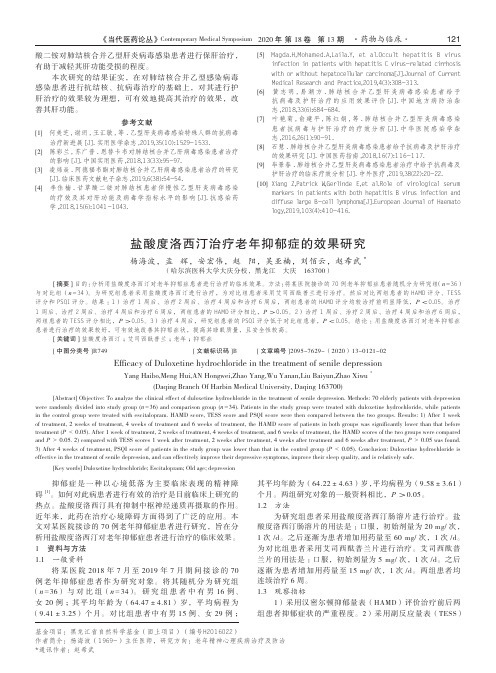
《当代医药论丛》Contemporary Medical Symposium 2020 年 第 18 卷 第 13 期 ·药物与临床·121盐酸度洛西汀治疗老年抑郁症的效果研究杨海波,孟 辉,安宏伟,赵 阳,吴亚楠,刘佰云,赵希武*(哈尔滨医科大学大庆分校,黑龙江 大庆 163700)[摘要]目的:分析用盐酸度洛西汀对老年抑郁症患者进行治疗的临床效果。
方法:将某医院接诊的70例老年抑郁症患者随机分为研究组(n=36)与对比组(n=34)。
为研究组患者采用盐酸度洛西汀进行治疗,为对比组患者采用艾司西酞普兰进行治疗。
然后对比两组患者的HAMD 评分、TESS 评分和PSQI 评分。
结果:1)治疗1周后、治疗2周后、治疗4周后和治疗6周后,两组患者的HAMD 评分均较治疗前明显降低,P <0.05。
治疗1周后、治疗2周后、治疗4周后和治疗6周后,两组患者的HAMD 评分相比,P >0.05。
2)治疗1周后、治疗2周后、治疗4周后和治疗6周后,两组患者的TESS 评分相比,P >0.05。
3)治疗4周后,研究组患者的PSQI 评分低于对比组患者,P <0.05。
结论:用盐酸度洛西汀对老年抑郁症患者进行治疗的效果较好,可有效地改善其抑郁症状,提高其睡眠质量,且安全性较高。
[关键词]盐酸度洛西汀;艾司西酞普兰;老年;抑郁症[中图分类号]R749 [文献标识码]B [文章编号]2095-7629-(2020)13-0121-02Efficacy of Duloxetine hydrochloride in the treatment of senile depressionYang Haibo,Meng Hui,AN Hongwei,Zhao Yang,Wu Yanan,Liu Baiyun,Zhao Xiwu *(Daqing Branch Of Harbin Medical University, Daqing 163700)[Abstract] Objective: To analyze the clinical effect of duloxetine hydrochloride in the treatment of senile depression. Methods: 70 elderly patients with depression were randomly divided into study group (n=36) and comparison group (n=34). Patients in the study group were treated with duloxetine hydrochloride, while patients in the control group were treated with escitalopram. HAMD score, TESS score and PSQI score were then compared between the two groups. Results: 1) After 1 week of treatment, 2 weeks of treatment, 4 weeks of treatment and 6 weeks of treatment, the HAMD score of patients in both groups was significantly lower than that before treatment (P < 0.05). After 1 week of treatment, 2 weeks of treatment, 4 weeks of treatment, and 6 weeks of treatment, the HAMD scores of the two groups were compared and P > 0.05. 2) compared with TESS scores 1 week after treatment, 2 weeks after treatment, 4 weeks after treatment and 6 weeks after treatment, P > 0.05 was found. 3) After 4 weeks of treatment, PSQI score of patients in the study group was lower than that in the control group (P < 0.05). Conclusion: Duloxetine hydrochloride is effective in the treatment of senile depression, and can effectively improve their depressive symptoms, improve their sleep quality, and is relatively safe.[Key words] Duloxetine hydrochloride; Escitalopram; Old age; depression酸二铵对肺结核合并乙型肝炎病毒感染患者进行保肝治疗,有助于减轻其肝功能受损的程度。
HPLC法测定盐酸度洛西汀的含量及有关物质
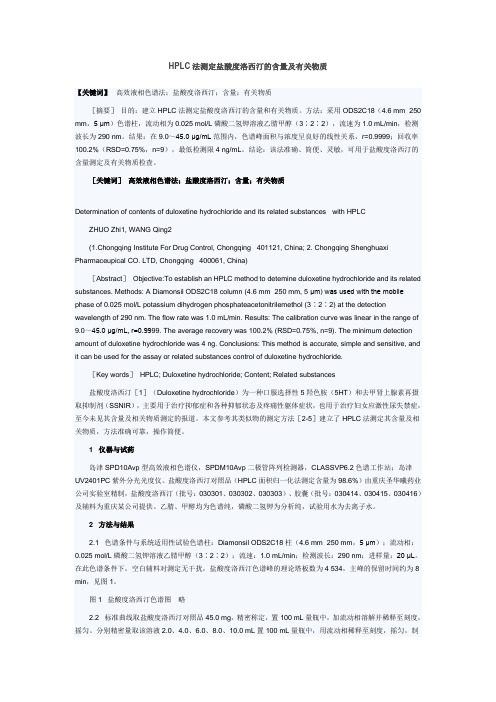
HPLC法测定盐酸度洛西汀的含量及有关物质【关键词】高效液相色谱法;盐酸度洛西汀;含量;有关物质[摘要]目的:建立HPLC法测定盐酸度洛西汀的含量和有关物质。
方法:采用ODS2C18(4.6 mm×250 mm,5 μm)色谱柱,流动相为0.025 mol/L磷酸二氢钾溶液乙腈甲醇(3∶2∶2),流速为1.0 mL/min,检测波长为290 nm。
结果:在9.0~45.0 μg/mL范围内,色谱峰面积与浓度呈良好的线性关系,r=0.9999;回收率100.2%(RSD=0.75%,n=9),最低检测限4 ng/mL。
结论:该法准确、简便、灵敏,可用于盐酸度洛西汀的含量测定及有关物质检查。
[关键词]高效液相色谱法;盐酸度洛西汀;含量;有关物质Determination of contents of duloxetine hydrochloride and its related substances with HPLC ZHUO Zhi1, WANG Qing2(1.Chongqing Institute For Drug Control, Chongqing 401121, China; 2. Chongqing Shenghuaxi Pharmaceupical CO. LTD, Chongqing 400061, China)[Abstract]Objective:To establish an HPLC method to detemine duloxetine hydrochloride and its related substances. Methods: A Diamonsil ODS2C18 column (4.6 mm×250 mm, 5 μm) was used with the mobile phase of 0.025 mol/L potassium dihydrogen phosphateacetonitrilemethol (3∶2∶2) at the detection wavelength of 290 nm. The flow rate was 1.0 mL/min. Results: The calibration curve was linear in the range of 9.0~45.0 μg/mL, r=0.9999. The average recovery was 100.2% (RSD=0.75%, n=9). The minimum detection amount of duloxetine hydrochloride was 4 ng. Conclusions: This method is accurate, simple and sensitive, and it can be used for the assay or related substances control of duloxetine hydrochloride.[Key words]HPLC; Duloxetine hydrochloride; Content; Related substances盐酸度洛西汀[1](Duloxetine hydrochloride)为一种口服选择性5羟色胺(5HT)和去甲肾上腺素再摄取抑制剂(SSNIR),主要用于治疗抑郁症和各种抑郁状态及疼痛性躯体症状,也用于治疗妇女应激性尿失禁症,至今未见其含量及相关物质测定的报道。
盐酸度洛西汀获准用于新的适应证
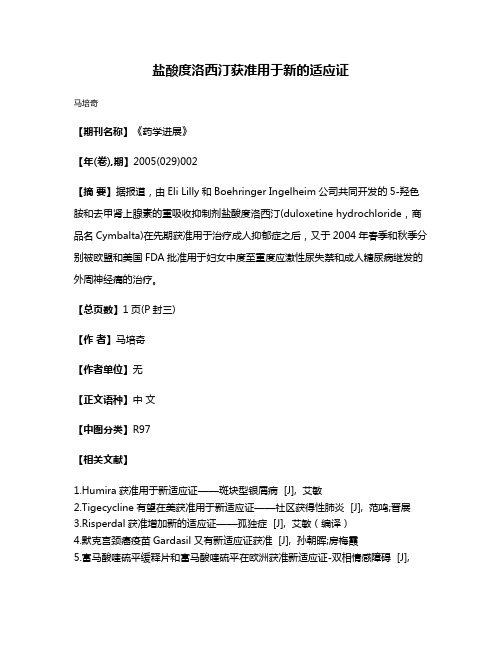
盐酸度洛西汀获准用于新的适应证
马培奇
【期刊名称】《药学进展》
【年(卷),期】2005(029)002
【摘要】据报道,由Eli Lilly和Boehringer Ingelheim公司共同开发的5-羟色胺和去甲肾上腺素的重吸收抑制剂盐酸度洛西汀(duloxetine hydrochloride,商品名Cymbalta)在先期获准用于治疗成人抑郁症之后,又于2004年春季和秋季分别被欧盟和美国FDA批准用于妇女中度至重度应激性尿失禁和成人糖尿病继发的外周神经痛的治疗。
【总页数】1页(P封三)
【作者】马培奇
【作者单位】无
【正文语种】中文
【中图分类】R97
【相关文献】
1.Humira获准用于新适应证——斑块型银屑病 [J], 艾敏
2.Tigecycline有望在美获准用于新适应证——社区获得性肺炎 [J], 范鸣;晋展
3.Risperdal获准增加新的适应证——孤独症 [J], 艾敏(编译)
4.默克宫颈癌疫苗Gardasil又有新适应证获准 [J], 孙朝晖;房梅霞
5.富马酸喹硫平缓释片和富马酸喹硫平在欧洲获准新适应证-双相情感障碍 [J],
因版权原因,仅展示原文概要,查看原文内容请购买。
- 1、下载文档前请自行甄别文档内容的完整性,平台不提供额外的编辑、内容补充、找答案等附加服务。
- 2、"仅部分预览"的文档,不可在线预览部分如存在完整性等问题,可反馈申请退款(可完整预览的文档不适用该条件!)。
- 3、如文档侵犯您的权益,请联系客服反馈,我们会尽快为您处理(人工客服工作时间:9:00-18:30)。
Duloxetine Hydrochloride(doo lox' e teen hye'' droe klor' ide).C18H19NOS ·HCl 333.882-Thiophenepropanamine, N-methyl--(1-naphthalenyloxy)-, hydrochloride, (S)-; (+)-(S)-N-Methyl--(1-naphthyloxy)-2-thiophenepropylamine hydrochloride[136434-34-9].DEFINITIONDuloxetine Hydrochloride contains NLT 97.0% and NMT 102.0% of C18H19NOS ·HCl, calculated on the dried basis.IDENTIFICATIONChange to read:• A. Infrared Absorption 197K (ERR 1-Jul-2012)• B. The retention time of the major peak in the Sample solution correspondsto that of the duloxetine S-isomer from the System suitability solution in the test for Limit of Duloxetine Related Compound A.Change to read:• C. Identification Tests —General, Chloride 191Sample solution: 5 mg/mL in methanolAcceptance criteria: Meets the requirements (ERR 1-Jul-2012)ASSAY• ProcedureProtect solutions of duloxetine from light.Buffer: 2.9 g/L of phosphoric acid in water. Adjust with sodium hydroxide solution to a pH of 2.5. To each L of this solution add 10.3 g of sodium 1-hexanesulfonate monohydrate, and dissolve.Mobile phase: Acetonitrile, n-propanol, and Buffer (13:17:70)Diluent: Acetonitrile and water (25:75)ClickSystem suitability solution: 0.2 mg/mL of USP Duloxetine Hydrochloride RS in Mobile phase. Heat the solution to at least 40for a minimum of 1 h.[Note —The resulting solution contains duloxetine impurity B, duloxetine impurity C, duloxetine impurity D, duloxetine impurity E, and duloxetine related compound F. ] Standard solution: 0.1 mg/mL of USP Duloxetine Hydrochloride RS in DiluentSample solution: 0.1 mg/mL of Duloxetine Hydrochloride in DiluentChromatographic system(See Chromatography 621, System Suitability .)Mode: LCDetector: UV 230 nmColumn: 4.6-mm × 15-cm; 3.5-µm packing L7Column temperature: 40 ± 3Flow rate: 1 mL/minInjection size: 10 µLRun time: 2 times the retention time of duloxetineSystem suitabilitySample: System suitability solution[Note —See Table 1 for relative retention times. ]Suitability requirements Resolution: NLT 1.5 between duloxetine and duloxetine relatedcompound F peaksTailing factor: NMT 1.5 for the duloxetine peakRelative standard deviation: NMT 1.0% for the duloxetine peakAnalysisSamples: Standard solution and Sample solutionCalculate the percentage of duloxetine hydrochloride (C18H19NOS ·HCl) in the portion of sample taken:Result = (rU/rS) × (CS/CU) × 100Acceptance criteria: 97.0%–102.0% on the dried basisIMPURITIES• Heavy Metals, Method II 231: NMT 10 ppm• Residue On Ignition281: NMT 0.2% rU =peak response from the SamplesolutionrS =peak response from the StandardsolutionCS =concentration of USP DuloxetineHydrochloride RS in the Standardsolution (mg/mL)CU =concentration of DuloxetineHydrochloride in the Sample solution(mg/mL)• Organic ImpuritiesProtect solutions of duloxetine from light.Buffer, Mobile phase, Diluent, and System suitability solution: Proceed as directed in the Assay.Sensitivity solution: 0.2 µg/mL of USP Duloxetine Hydrochloride RS in DiluentSample solution: 0.2 mg/mL of Duloxetine Hydrochloride in DiluentChromatographic system: Proceed as directed in the AssayRun time: 2.4 times the retention time of duloxetineSystem suitabilitySamples: System suitability solution and Sensitivity solution[Note —See Table 1 for relative retention times. ]Suitability requirementsResolution: NLT 1.5 between duloxetine impurity C and duloxetineimpurity D; NLT 1.5 between duloxetine and duloxetine relatedcompound F, System suitability solutionTailing factor: NMT 1.5 for the duloxetine peak, System suitabilitysolutionRelative standard deviation: NMT 1.0% for the duloxetine peak, System suitability solutionSignal-to-noise ratio: NLT 20 for the duloxetine peak, Sensitivity solution AnalysisSample: Sample solutionCalculate the percentage of any individual impurity in the portion ofDuloxetine Hydrochloride taken:Result = (rU/rT) × (1/F) × 100Acceptance criteria: See Table 1. Table 1 rU =peak response of each impurity fromthe Sample solutionrT =sum of the responses of all the peaksfrom the Sample solutionF =relative response factor (see Table 1)Name Relative Retention TmeRelative Response Factor AcceptanceCriteriaNMT (%)Duloxetine impurity B a ,g 0.150.36—Duloxetine impurity C b ,g0.43 1.0—Duloxetine impurity D c ,g0.48 1.8—Duloxetine impurity E d ,g0.74 1.0—Duloxetine 1.0——• Limit of Duloxetine Related Compound AMobile phase: Hexane and isopropyl alcohol (83:17). To 1 L of this mixture add 2 mL of diethylamine.System suitability solution: 0.1 mg/mL each of USP DuloxetineHydrochloride RS and USP Duloxetine Related Compound A RS inMobile phase. Sonication may be used to aid in dissolution.Sensitivity solution: 0.1 µg/mL of USP Duloxetine Hydrochloride RS in Mobile phaseSample solution: 0.1 mg/mL of Duloxetine Hydrochloride in Mobile phase.Sonication may be used to aid in dissolution.Chromatographic system (See Chromatography 621, System Suitability .)Mode: LCDetector: UV 230 nmColumn: 4.6-mm × 25-cm; 5-µm packing L40Column temperature: 40Flow rate: 1 mL/minInjection size: 10 µLRun time: 2 times the retention time of duloxetineSystem suitabilitySamples: Sensitivity solution and System suitability solution[Note —The relative retention times for duloxetine and duloxetine related compound A are 1.0 and 1.3, respectively. ]Suitability requirementsResolution: NLT 3.5 between duloxetine and duloxetine relatedcompound A, System suitability solutionTailing: Between 0.8 and 1.5 each for duloxetine and duloxetine related compound A peaks, System suitability solutionRelative standard deviation: NMT 5.0% for the duloxetine peak, System suitability solutionSignal-to-noise ratio: NLT 3, Sensitivity solutionAnalysisDuloxetine related compound F e 1.1 1.00.5Duloxetine impurity G f ,g 1.40.51—Any individual unspecified impurity — 1.00.1Total impurities——0.6a 3-(Methylamino)-1-(thiophen-2-yl)propan-1-ol.b 4-[3-(Methylamino)-1-(thiophen-2-yl)propyl]naphthalen-1-ol.c Naphthalen-1-ol.d 1-(3-(Methylamino)-1-(thiophen-2-yl)propyl)naphthalen-2-ol.e (S)-N-Methyl-3-(naphthalen-1-yloxy)-3-(thiophen-3-yl)propan-1-amine.f 1-Fluoronaphthalene.g Controlled at Any individual unspecified impurity level.Sample: Sample solutionCalculate the percentage of duloxetine related compound A in the portion of Duloxetine Hydrochloride taken:Result = (rU/rT) × 100Acceptance criteria: NMT 0.5%SPECIFIC TESTS• Loss On Drying 731: Dry at 105 for 3 h: it loses NMT 0.5% of its weight. ADDITIONAL REQUIREMENTS• Packaging And Storage: Protect from light. Store at room temperature. • USP Reference Standards 11:USP Duloxetine Hydrochloride RSUSP Duloxetine Related Compound A RS(R)-N-Methyl-3-(naphthalen-1-yloxy)-3-(thiophen-2-yl)propan-1-amine hydrochloride.C18H19NOS ·HCl 333.88Auxiliary Information — Please check for your question in the FAQs before contactingUSP. USP36–NF31 Page 3354Pharmacopeial Forum: Volume No. 37(4)Chromatographic Column —DULOXETINE HYDROCHLORIDEChromatographic columns text is not derived from, and not part of, USP 36 or NF 31.rU =peak response for duloxetine relatedcompound A from the SamplesolutionrT =sum of the responses of duloxetineand duloxetine related compound Apeaks from the Sample solutionTopic/Question Contact Expert CommitteeMonograph Heather R. Joyce, Ph.D. Associate Scientific Liaison1-301-918-8442(SM42010) Monographs - SmallMolecules 4Reference Standards RS Technical Services1-301-816-8129rstech@。
